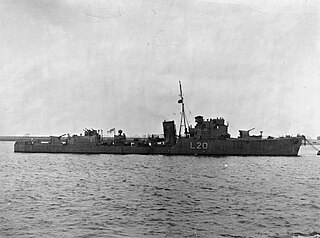
The Hunt class was a class of escort destroyer of the Royal Navy. The first vessels were ordered early in 1939, and the class saw extensive service in the Second World War, particularly on the British east coast and Mediterranean convoys. They were named after British fox hunts. The modern Hunt-class GRP hulled mine countermeasure vessels maintain the Hunt names lineage in the Royal Navy.

ORP Krakowiak was a British Type II Hunt-class destroyer escort, used by the Polish Navy during World War II. Initially built for the Royal Navy, it bore the name of HMS Silverton during British use.

HMS Whaddon (L45) was a Type I Hunt-class destroyer of the Royal Navy built by Alexander Stephen & Sons of Linthouse, Govan and launched on 16 July 1940. She was laid down on 27 July 1939 and commissioned 28 February 1941. She was adopted by the civil community of Newport Pagnell in Buckinghamshire, as part of the Warship Week campaign in 1942.

HMS Beaufort was a Hunt-class destroyer of the Royal Navy. She was laid down on 17 July 1940 at Cammell Laird, Birkenhead. She was launched on 9 June 1941 and commissioned on 3 November 1941. During the Second World War the ship served in the Mediterranean Sea, escorting convoys and covering landings. She was transferred to the Royal Norwegian Navy in 1952 and scrapped in 1965.

HMS Eridge was a Hunt-class destroyer of the Royal Navy. She was launched in 1940 and served during the Second World War.

HMS Chiddingfold (L31) was a Type II Hunt-class destroyer of the Royal Navy. She was leased to the Indian Navy in 1952 where she served as INS Ganga (D94).

HMS Wheatland was a Type 2 Hunt-class destroyer of the Royal Navy that served in the Second World War.

HMS Cattistock (L35) was a Type I Hunt-class destroyer of the Royal Navy. She was a member of the first subgroup of the Hunt class and served throughout World War II before being scrapped in 1957.

HMS Meynell was a Type I Hunt-class destroyer of the Royal Navy which served in World War II. She was sold to Ecuador in 1954 where she served as Presidente Velasco Ibarra.

HMS Eglinton (L87) was a Type I Hunt-class destroyer of the Royal Navy built by Vickers-Armstrongs on the River Tyne, and launched on 28 December 1939. She was adopted by the town of Alton, Hampshire, as part of the Warship Week campaign in 1942.

HMS Garth was a Type I Hunt-class destroyer of the Royal Navy built by John Brown & Company on the River Clyde, and launched on 28 December 1939. She was adopted by the Civil Community of Wokingham, Berkshire, as part of the Warship Week campaign in 1942.

HMS Cotswold was a Type I Hunt-class destroyer of the Royal Navy which served in World War II. She was scrapped in 1957.

HMS Pytchley was a Type I Hunt-class destroyer of the Royal Navy which served in World War II. She was scrapped in 1956.

HMS Southdown was a Type I Hunt-class destroyer of the Royal Navy which served in World War II. She was scrapped in 1956.

HMS Cowdray was a Type II Hunt-class destroyer of the Royal Navy which served in World War II. She has been the only Royal Navy ship to bear the name. She was scrapped in 1959.

HMS Farndale was a Type 2 Hunt-class destroyer of the Royal Navy which served in World War II. She was scrapped in 1962. She has been the only British Warship so far to bear this name.

HMS Wilton was a Type 2 Hunt-class destroyer of the Royal Navy that served in the Second World War.

HMS Melbreak was a Hunt-class destroyer of the Royal Navy. She was a member of the third subgroup of the class, and saw service in the Second World War. All the ships of this class were named after British fox hunts. She was the first Royal Navy warship with this name, after the Melbreak hunt in Cumbria. In 1942 she was adopted by the civil community of Cockermouth in Cumberland, as part of Warship Week.

HMS Bleasdale was a Hunt-class destroyer of the Royal Navy. She was a member of the third subgroup of the class, and saw service in the Second World War. All the ships of this class were named after British fox hunts. She was the first Royal Navy warship with this name, after the Bleasdale hunt in Lancashire. In 1942 she was adopted by the civil community of Garstang in Lancashire, as part of Warship Week.
HMS Fernie was a Type I Hunt-class destroyer built for the Royal Navy completed in mid-1940. She was adopted by the Civil Community of Market Harborough, Leicestershire, as part of the Warship Week campaign in 1942. She has been the only ship in the Royal Navy to carry this name.



















